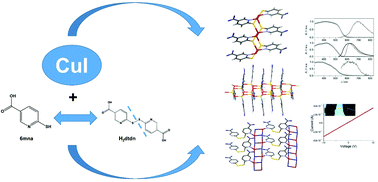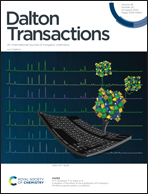Multifunctional coordination polymers based on copper(i) and mercaptonicotinic ligands: synthesis, and structural, optical and electrical characterization†
Abstract
Three new coordination polymers (CPs) named [Cu(6mna)]n (CP1), [CuCl(H6mna)(H2O)0.33]n (CP2), and {[(CuI)2H2dtdn].MeCN}n (CP3), (H6mna = 6-mercaptonicotinic acid, and H2dtdn = 6,6′-dithiodinicotinic acid) have been synthesized and their structures determined by single-crystal X-ray diffraction. Complexes 1 and 3 are 2D-CPs while complex 2 is a 1D-CP. The optical properties of these complexes have been evaluated in the solid state, at room temperature and at 77 K, and compared with those of the starting ligands. The electrical conductivity of CPs 1–3 has been evaluated and their thermal stabilities have been studied. CP2 shows an interesting crystal arrangement, where the connection between the ligand and the copper forms a channel-like structure characterized by an intrinsic disorder. Crystal data collected at low temperatures for this complex revealed minor structural changes in the Cu⋯Cu distances and Cu–S–Cu angles along the chain, excluding phase transition. In CP1, the N and S atoms are involved in metal coordination bonds giving rise to a 2D coordination polymer. In CP3, the Cu-I bonds compose double ladder-like structures, bridged by H2dtdn ligands. The electrical conductivities of CPs 1–3 suggest their semiconductive behavior.



 Please wait while we load your content...
Please wait while we load your content...